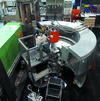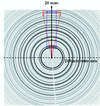issue contents
December 2018 issue

Cover illustration: Gailhanou & Roussel [J. Appl. Cryst. (2018), 51, 1586-1596] show, using kinematic theory, that the helical nature of twisted nanowires is revealed in X-ray diffraction patterns by either elastic or shape anisotropy.
research papers
Open  access
access
 access
accessThe technical features and performance of a new instrument for time-resolved ultra-small-angle and coherent X-ray scattering are presented. The instrument enables static and kinetic investigations from ångström to micrometre size scales and time resolution down to the sub-millisecond range. Applications include elucidation of static and transient hierarchical structures in soft matter and biophysical systems.
A method to automatically index electron backscatter diffraction patterns is introduced and demonstrated with dynamical diffraction simulations and experimental patterns.
The scattering contribution of free, not chemically bound water in different water–solid mixtures as well as the changes of the scattering contribution due to the reaction progress of hydrating systems is examined. Rietveld analysis with a combination of the G factor and PONKCS (partial or no known crystal structure) method is used for quantification.
The local atomic motif method is further refined and applied to amorphous germanium models, revealing subtle differences between two similar models.
During polarity-inverted lateral overgrowth, inversion domain boundaries (IDBs) are found to be formed on the energetically less favorable  plane. A model that takes a geometrical factor into consideration can explain this preferential tendency of IDB formation. Computational simulations based on the proposed model are consistent with experimental results.
plane. A model that takes a geometrical factor into consideration can explain this preferential tendency of IDB formation. Computational simulations based on the proposed model are consistent with experimental results.
Neutron reflectivity on metallic superlattices is used to measure the volume expansion induced by deuterium content. The differences between treating the data with simple Gaussian fits and full reflectivity fits using Parratt's recursive method are shown and an explanation is proposed.
Open  access
access
 access
accessQuasielastic neutron scattering is applied to analyse the atomic scale hydrogen transport processes occurring within the crystal lattices of hydrous minerals. Two types of transport processes were observed in Mg(OH)2, which has a prototypical layered hydrogen lattice structure.
Open  access
access
 access
accessEnergy-dispersive X-ray diffraction implemented in a back-reflection geometry has unique characteristics, particularly its insensitivity to sample morphology. The potential to develop a handheld X-ray diffraction instrument based on this technique is explored with the help of a prototype instrument adapted from a handheld X-ray fluorescence device.
It is shown, using kinematic theory, that the helical nature of twisted nanowires is revealed in X-ray diffraction patterns by either elastic or shape anisotropy.
Data collection and reduction on the ECHIDNA neutron powder diffractometer are described in detail, along with achievements and highlights from over ten years of operation. This paper replaces the previous design report as the canonical reference for ECHIDNA-derived data.
A small-angle neutron scattering instrument based on a multi-pinhole collimator system is used to increase neutron current at the sample compared with a single-pinhole collimator system. Disadvantages such as crosstalk and reflection noise are overcome by the described optimization.
The results of research into the three-dimensional structure of dislocation half-loops in silicon single crystals using laboratory X-ray and synchrotron sources are presented.
Open  access
access
 access
accessSize-exclusion chromatography coupled with a laboratory-based small-angle X-ray scattering setup is presented and its performance evaluated for studies of various proteins covering a broad range of molecular weights.
The upgraded biological small-angle X-ray scattering (SAXS) station at the Shanghai Synchrotron Radiation Facility is equipped with an in-vacuum automated sample loading system, an inline Agilent high-performance liquid chromatography system and a Wyatt light scattering device. The versatile sample environments and easy-to-access remote-control platform make the high-brightness beamline BL19U2 ideally suitable for performing SAXS experiments on biological macromolecules in solution.
FeO reduced by CO/H2 was investigated by density functional theory, and the conditions for iron whisker growth in CO/H2 were calculated.
Download citation


Download citation


Open  access
access
 access
accessA semi-automated routine for continuous rotation electron diffraction has been developed, enabling high-throughput data collection. Serial electron crystallography combined with a deep convolutional network are used to screen for suitable crystals.
The wavelength, the scattering vector magnitude and the absolute intensity for the Suanni small-angle neutron scattering spectrometer have been calibrated by using standard samples, providing an informative reference for users and diagnostic tools for instrument scientists.
Effects of relative humidity on a novel monoclinic crystal form of hen egg-white lysozyme are assessed via in situ laboratory X-ray powder diffraction.
Limited X-ray and section topography have been used to characterize defects in both boron-doped homoepitaxial films and high-pressure high-temperature 1b (001) diamond substrates. Lattice mismatch generates, at the interface, two orthogonal systems of misfit dislocations in the form of half-loops propagating from the interface defects, particularly threading dislocations and growth sector boundaries.
In situ combined X-scattering techniques (XRR and XRD) on a laboratory tool provide details insight into the mechanical behaviour and volume shrinkage upon crystallization of phase-change Ge2Sb2Te5 films. The effect of nitrogen incorporation into Ge2Sb2Te5 is studied.
The present work reports a method for treating the anisotropic small-angle scattering from sintered Mo-base materials. The method yields the morphology and quantity of uniaxially deformed sinter pores and of aligned anisotropic precipitates.
This study demonstrates a novel probing parameter, the electron work function, for surface analysis and its correlation with the dependence of surface properties on crystallographic orientation.
The high-resolution powder diffraction setup of the ESRF ID22 beamline has been combined with a two-dimensional Pilatus3 X CdTe 300 K-W detector, offering new possibilities in terms of data handling and improving the overall performance of high-resolution powder diffraction.
teaching and education
Free 

EwaldSphere is a Microsoft Windows program that simulates a small-molecule X-ray diffractometer and the normally invisible components of the diffraction process. The program is designed mainly for teaching the basic concepts of diffraction by allowing the user to explore a three-dimensional model of the Ewald sphere construction.
short communications
Powder diffraction data sharing is coming. A discussion about which raw data should be shared is triggered.
computer programs
Open  access
access
 access
accessInteractiveXRDFit is a custom-made MATLAB program that calculates the X-ray diffracted intensity for heterostructures.
Macros implementing the main concepts of the whole powder pattern modelling approach have been written for TOPAS, taking into account the size and strain broadening components of the diffraction line profiles.
laboratory notes
This study investigates the neutron scattering signals from different adhesives that are commonly used to mount samples. The pros and cons of each glue are discussed, including when to use (or not use) each.
book reviews
Free 



 journal menu
journal menu


















































